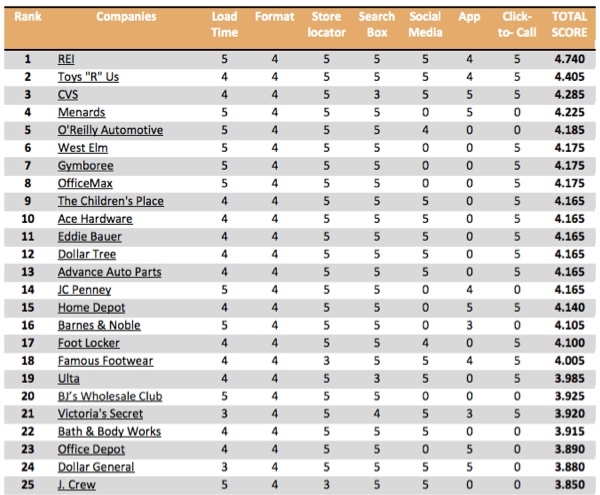With the holiday season fast approaching, and the mobile device playing a big role in the shopping experience, online retailers should put their mobile shopper front and center. You might think the big ecommerce brands already have that figured out, but The Search Agency released today another iteration of its mobile experience scorecard assessing 100 multichannel retailers to see how well they did when it came to following mobile best practices online.
Out of the 100 brands examined, not one ecommerce site received a perfect score of 5; the average score was just over 3.

Winners included:
- REI, which took top honors with a score of 4.74
- Toys “R” Us, coming in at second with 4.40
- CVS at third place with a score of 4.28
Which retailer came in dead last? You may be surprised to find out it was Apple, with a score of 0.68, which put it in 100th place.
The Search Agency analyzed the largest online retailers in the United States against seven factors in the mobile retail experience:
- Load time
- Site format
- Store locator
- Search box
- Social media
- Apps
- Click-to-call
The weighted scorecard looked like this:

Here’s a snapshot of the Top 25 that are winning the mobile retail experience:

Of those sites examined, only one out of 100 employed responsive web design (Carters.com), while others with a mobile experience had a dedicated mobile site.

In its report, The Search Agency gave some best practice tips for online retailers regarding their site format and navigation:
Consider using Responsive Web Design (RWD), the mobile configuration recommended by Google. Using RWD “preserves a canonical URL, avoiding any complicated redirects, and simplifies the sharing of web addresses.”
Although the majority of sites in this report scored highly using dedicated mobile sites, RWD was weighted more heavily because it is the industry standard for rendering sites across devices.
By implementing RWD, marketers ensure that their sites can be rendered across all current AND future devices of all dimensions (i.e. wearable technology, etc.).
RWD allows you to have a single, dynamic site which allows traffic, authority, and link value to be consolidated to one domain and easily sorted, tracked, and measured through popular Analytics packages.
RWD eliminates the need to maintain and monitor several versions of the site, and it consolidates traffic and link value to the canonical version of the site.
RWD ensures that all backlinks will lead to a properly rendered site, which improves user experience and site engagement.
Include a store locator feature to help consumers find brick-and-mortar store locations quickly and easily while they are on the go.
Include a click-to-call feature to allow consumers to easily find a nearby store’s phone number to contact a brick-and-mortar location quickly.
Place the most important information for consumers at the top of the page or above the fold where viewers can easily find it.



